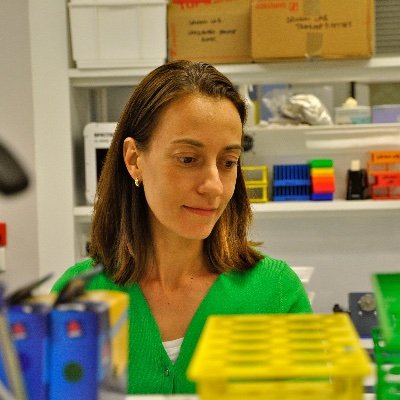
Sunniyat Rahman
@minimolecule
Followers
355
Following
723
Media
15
Statuses
215
ARCHIVED, Follow on 🦋| Postdoc at @TheDawsonLab, Peter Mac & Hon. Senior Research Fellow at UCL Cancer Institute
Melbourne
Joined September 2011
Focal deletions of noncoding regions in cancer genomes can have unexpected consequences. Out now in @BloodJournal, we’ve discovered an intriguing mechanism of oncogene activation whereby focal deletion of a ‘promoter tether’ leads to aberrant expression of IRX3 in T-ALL. Thread👇
4
16
70
This study expands the compendium of non-coding elements that regulate oncogene activation and underscores the need for comprehensive genomic characterization of leukemias
0
1
6
Incredibly grateful for the expertly titled and superb commentary by @IlariaIacobucc1 and @LeMonte63 of @StJudeResearch highlighting our recent discovery of a proposed new class of noncoding element (promoter tether) that blocks inappropriate oncogene activation. Have a read👇
Thankful to @BloodJournal for the opportunity to write a commentary on the elegant study by @minimolecule and colleagues. ❗️Check it out to learn how the loss of a “promoter tether” induces IRX3 oncogenic activation in T-ALL. @LeMonte63 @StJudeResearch
0
0
5
As of last week I’ve moved to SciSky. Find me there🦋 (I’ve got the same handle😉)
0
0
4
‘Noncoding’ regions in DNA act like switches, turning genes on and off at the right times. But what happens when these switches break - or get deleted? 🧬 In our latest blog, we delve into these ‘deletions’ and their link to leukaemia. 👇 https://t.co/iNMmJACidE
leukaemiauk.org.uk
Join us as we explore the connection between focal deletions in DNA and how they contribute to a subtype of leukaemia.
0
3
5
Thrilled to share our new paper! Congratulations @SHollizeck, Ning Wang, @dineika_chandra who led the work @TheDawsonLab @PeterMacRes @GenCancerCentre Unravelling mutational signatures with plasma circulating tumour DNA
nature.com
Nature Communications - Accurately detecting cancer mutational profiles from circulating tumour DNA (ctDNA) remains a challenging task. Here, the authors develop MisMatchFinder, an algorithm that...
5
18
78
This research was funded by @LeukUK @CR_UK @GOSHCharity and others. None of these discoveries would be possible without the support and consent from patients and their families. This discovery is for them.
0
0
1
A huge thanks to all collaborators involved for their expert input @drdavidoconnor @AdamTurna2 @AdeleKFielding @MaDawidowska @pvvlab @JulietteRoels @SueHadjur @jrmmhughes @jojdavies @theaglab @MichelleKellih3 @VanLooLab and those not on Twitter/X. And to the peer reviewers!
1
0
1
I want to highlight the incredible support of @MAF_Dawson who has welcomed me into his lab at a critical point in my academic career and my previous mentor @marcrmansour for his advice and guidance on this project and beyond
1
0
0
A special thanks to the incredibly talented @gianna_bloye who completed critical parts of this paper and is now doing her PhD @UniofOxford. And to @NadineFarah3 and @zeunas who have been on this challenging expedition with me to find cis-acting noncoding mutations in T-ALL.
1
0
2
We speculate that ‘promoter tethering’ of oncogenes to inert regions of the genome is a previously unappreciated mechanism preventing tumorigenesis, and postulate similar mechanisms may be found in other cancers.
1
0
0
These findings also add to the complex regulatory relationship between the FTO and IRX3 genes, first identified through the discovery of obesity-associated germline variants.
1
0
0
This mechanism differs to previously described enhancer hijack events, which bring enhancers and promoters together through structural rearrangement. And differs to examples of focal deletions that impinge on TAD boundaries as we believe this all happens intra-TAD
1
0
0
These data suggest IRX3 is sequestered to FTO intron 8 through a ‘promoter tether’ facilitated by CTCF. Loss of this CTCF site by focal deletion untethers the IRX3 promoter allowing for enhancer hijack. This may be an example of E-P competition occurring within the same TAD
1
0
1
By using CRISPR/Cas9 we disrupted the CRNDE super-enhancer in FTO intron 8 CTCF site deleted cells (ALLSIL). This led to a significant reduction in IRX3 expression, meaning this super-enhancer is indeed hijacked by IRX3.
1
0
0
So what’s the deal with CRNDE? It encodes for a lncRNA that is actively transcribed throughout T cell development and harbours a super-enhancer. HiChIP shows this super-enhancer loops to IRX3 suggesting its hijacked in FTO intron 8 CTCF site deleted T-ALL cells (ALLSIL)
1
0
0
We also baited the IRX3 promoter in our CRISPR/Cas9 edited cells (PF382) with and without the FTO intron 8 CTCF site, observing the same effect of increased contacts with the CRNDE region along with increased transcriptional output of IRX3.
1
0
0
In contrast doing the same with FTO intron 8 CTCF site deleted cells (ALLSIL) massively increased the contacts between the IRX3 promoter and CRNDE along with transcriptional activation of IRX3. Look at the contact delta 👆(above)
1
0
0
With UMI-4C we baited the CTCF site in FTO wild-type cells (PF382). This showed that IRX3 is ‘tethered’ to FTO intron 8. In the same cells we baited the IRX3 promoter which identified minimal contacts with CRNDE with no transcriptional output of IRX3.
1
0
0
CRISPR/Cas9-mediated deletion of the FTO intron 8 CTCF site in IRX3 negative (PF382) T-ALL cells transcriptionally activated IRX3 in single cell sorted clones and polyclonal populations, with no activation if you only delete the MYB site. This suggested the CTCF site was critical
1
0
0





